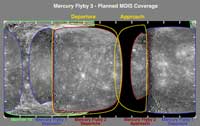|
COMETS EARTH JUPITER KUIPER BELT MARS MERCURY METEORITES NEPTUNE OORT CLOUD PLUTO SATURN SOLAR SYSTEM SPACE SUN URANUS VENUS ORDER PRINTS
PHOTO CATEGORIES SCIENCEVIEWS AMERICAN INDIAN AMPHIBIANS BIRDS BUGS FINE ART FOSSILS THE ISLANDS HISTORICAL PHOTOS MAMMALS OTHER PARKS PLANTS RELIGIOUS REPTILES SCIENCEVIEWS PRINTS
|
Related Documents
Download Options
Date of Mercury Flyby 3: September 29, 2009 Just one week from today, the MESSENGER spacecraft will pass a mere 228 kilometers (142 miles) above the surface of Mercury for the mission's third flyby of the Solar System's innermost planet. This figure shows the planned imaging coverage for the upcoming encounter. The area of the surface that will be imaged by MDIS during Mercury flyby 3 is outlined in yellow, and it includes a portion of Mercury's surface never before seen by spacecraft. Prior to the MESSENGER mission, only 45% of Mercury's surface had been seen by the Mariner 10 spacecraft. As shown in this figure, with the completion of MESSENGER's three Mercury flybys, nearly all of Mercury's surface will have been viewed at close range by spacecraft, with the exception of the polar regions. Along with imaging of previously unseen terrain, other imaging activities planned for Mercury flyby 3 include a high-resolution southern-hemisphere mosaic during departure and targeted observations of specific surface features selected on the basis of their importance for understanding the diversity of compositions among Mercury surface materials. Credit: NASA/Johns Hopkins University Applied Physics Laboratory/Carnegie Institution of Washington |
